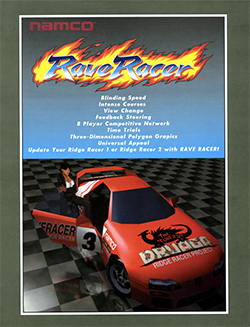| Rave Racer | |
|---|---|
 | |
| Developer(s) | Namco |
| Publisher(s) | Namco |
| Designer(s) | Kenji Wakabayashi, Fumihiro Tanaka |
| Composer(s) | Shinji Hosoe, Nobuyoshi Sano |
| Series | Ridge Racer |
| Platform(s) | Arcade |
| Release | |
| Genre(s) | Racing |
| Mode(s) | Single-player, multiplayer |
Rave Racer [a] is a 1995 arcade racing video game from Namco. It is the third title in the Ridge Racer series and the follow-up to Ridge Racer and Ridge Racer 2 . Rave Racer runs on Namco System 22 hardware, [3] and could be played by two people per cabinet for up to eight players total when up to four of them were linked together. [4] Compared to Ridge Racer 2, Rave Racer adds two new tracks as well as the ability to play the original two, various handling changes, force feedback steering, and improved car and racetrack graphics. [5] Rave Racer was a critical and commercial success; it would be the last major arcade Ridge Racer title as Namco would continue the series on home consoles with Rage Racer (1996) and R4: Ridge Racer Type 4 (1998).
